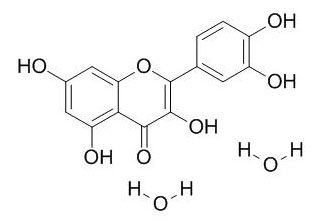Quercetin Dihydrate
Quercetin dihydrate loaded electrospun nanofibrous membrane show antimycotic effect on candida albicans. Clinoptilolite modified with quercetin dihydrate has shown better cytotoxicity compared with clinoptilolite modified with quercetin. The supplementation of quercetin dihydrate and gallate promotes an increase in fecal sterols, which in turn leads to a decreased absorption of dietary cholesterol as well as lower plasma and hepatic cholesterol.
Inquire / Order:
manager@chemfaces.com
Technical Inquiries:
service@chemfaces.com
Tel:
+86-27-84237783
Fax:
+86-27-84254680
Address:
1 Building, No. 83, CheCheng Rd., Wuhan Economic and Technological Development Zone, Wuhan, Hubei 430056, PRC
Providing storage is as stated on the product vial and the vial is kept tightly sealed, the product can be stored for up to
24 months(2-8C).
Wherever possible, you should prepare and use solutions on the same day. However, if you need to make up stock solutions in advance, we recommend that you store the solution as aliquots in tightly sealed vials at -20C. Generally, these will be useable for up to two weeks. Before use, and prior to opening the vial we recommend that you allow your product to equilibrate to room temperature for at least 1 hour.
Need more advice on solubility, usage and handling? Please email to: service@chemfaces.com
The packaging of the product may have turned upside down during transportation, resulting in the natural compounds adhering to the neck or cap of the vial. take the vial out of its packaging and gently shake to let the compounds fall to the bottom of the vial. for liquid products, centrifuge at 200-500 RPM to gather the liquid at the bottom of the vial. try to avoid loss or contamination during handling.
Pharmaceuticals (Basel).2021, 14(7):633.
Processes2021, 9(1), 153.
Foods.2023, 12(2):318.
Food Sci Biotechnol.2024, 34(3):611-620.
Univerzita Karlova2021, 20.500.11956.
Int J Mol Sci.2020, 21(6):2190.
Purinergic Signal.2024, doi: 10.1007.
Appl Biochem Biotechnol.2020, 190(2):732-744
Heliyon.2023, 9(11):e21944.
Asian Pac J Tropical Bio.2020, 10(6):239-247
Related and Featured Products
Microporous and Mesoporous Materials, 2012,147( 1): 59-67.
Modified natural clinoptilolite with quercetin and quercetin dihydrate and the study of their anticancer activity[Reference:
WebLink]
Natural zeolite of the clinoptilolite type and their modified forms CTQ and CTQD with low content (0.06% and 1%) of Q and QD have been used for the study of their anticancer activity.
METHODS AND RESULTS:
Carcinoma cell lines Jurkat, CEM, HeLa, MCF7, A549 and MDA were treated with various amounts of natural clinoptilolite and their modified forms CTQ and CTQD. The water content of the channel system influences the cytotoxicity of zeolite. The results of the study of pure CT thermally activated at two different temperatures 110 and 400 °C confirmed the better cytotoxicity of CT activated at 110 °C (CT110) with higher content of water in comparison with CT activated at 400 °C (CT400).
CONCLUSIONS:
Clinoptilolite modified with Quercetin Dihydrate (CTQD) has shown better cytotoxicity compared with clinoptilolite modified with quercetin (CTQ).
Int J Vitam Nutr Res. 2002 May;72(3):161-9.
Quercetin dihydrate and gallate supplements lower plasma and hepatic lipids and change activities of hepatic antioxidant enzymes in high cholesterol-fed rats.[Pubmed:
12098884 ]
This study was designed to test the lipid-lowering and antioxidant activity of two bioflavonoids, Quercetin Dihydrate and gallate.
METHODS AND RESULTS:
Four groups of rats were given a semisynthetic diet containing 10 g cholesterol/kg for six weeks. The control group received only a high-cholesterol diet, whereas the other three groups received a diet including 1 g lovastatin, 1 g Quercetin Dihydrate, or 1 g gallate/kg. The Quercetin Dihydrate and gallate supplements both significantly lowered the plasma lipid and hepatic cholesterol levels compared to those of the control. The hepatic 3-hydroxy-3-methylglutaryl-CoA (HMG-CoA) reductase activity was significantly lowered by the Quercetin Dihydrate when compared to the other groups, while the hepatic acyl CoA: cholesterol acyltransferase (ACAT) activity was only significantly higher in the control group. The overall potential for antioxidant protection was significantly enhanced by the Quercetin Dihydrate and gallate supplements through lowering the plasma and hepatic thiobarbituric acid reactive substances (TBARS) levels and increasing the hepatic superoxide dismutase (SOD) and glutathione peroxidase (GSH-Px) activities in high-cholesterol-fed rats.
CONCLUSIONS:
These results suggest that the supplementation of Quercetin Dihydrate and gallate promotes an increase in fecal sterols, which in turn leads to a decreased absorption of dietary cholesterol as well as lower plasma and hepatic cholesterol.
J Biotechnol Biomater 2012, 2(6):248.
Antimycolytic effect of quercetin dihydrate loaded electrospun nanofibrous membrane on Candida albicans[Reference:
WebLink]
Candida is an opportunistic fungus, known to cause systemic and life threatening infections in immunosuppressed patients. In our attempt to dealt with this ominous fungal pathogen we have successfully fabricated ultrafine poly (D,L-lactide-coglycolide), PLGA, nanofibrous membrane loaded with different concentrations of Quercetin Dihydrate, natural flavones with antioxidant and antimycolytic activity, using acetone-dichloromethane as solvent system.
CONCLUSIONS:
The bulk fabrication of these nanofibrous membrane was performed via electrospinning technique. The morphology of resulting nanofibrous membrane with or without Quercetin Dihydrate was examined using field emission scanning electron microscopy (FE-SEM). The nanofibrous membrane was also subjected to detailed analysis by Fourier transform infrared spectrometry (FTIR). The antimycolytic effect of these Quercetin Dihydrate loaded nanofibrous membrane on to the viability of C. albicans cells was established using modified XTT (2,3-bis(2-methoxy-4-nitro-5-sulfophenyl)-2H-tetrazolium-5-carboxanilide) reduction assay in 6 well polystyrene microtiter plates.



